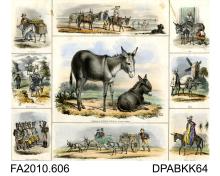You searched for: All
Results: 17234
Filter search results
-
Fine art GeorgianPrintHMCMS:FA2010.313Greig's print shows the gatehouse and bridge to Carisbrooke Castle which was constructed in the 17th-18th century. The construction of Carisbrooke Castle was part the Norman conquest as a way to ...Visit Page

-
Fine art GeorgianPrintHMCMS:FA2010.610The illustrations show the goat as having two main uses being for consumption or craftsmanship. Regarding consumption, goat's cheese was a popular staple among Mediterranean regions as goats were more ...Visit Page

-
Fine art GeorgianPrintsHMCMS:FA2010.609The illustrations show nine uses of the pig which can be used predominately for trade, food, leather and hog hair. Here, food is the most common use of pigs which is shown in the illustration in the ...Visit Page

-
Fine art GeorgianPrintsHMCMS:FA2010.608The illustrations show the uses of the reindeer and has many similarities to that shown of the camel, see HMCMS:FA2010.607. Here, the reindeer is used by nomads for transport and practical purposes ...Visit Page

-
Fine art GeorgianPrintsHMCMS:FA2010.607The plate has 10 named uses of camels shown in 8 illustrations. Similar to the ass (see HMCMS:FA2010.606), the camel is centred on being a practical beast of burden used in desert regions. Moreover ...Visit Page

-
Fine art GeorgianPrintHMCMS:FA2010.606Generally, while ass and donkey are used interchangeably, a donkey is considered to be a domesticated ass. As the illustrations show, the donkey predominately domesticated and used as a beast of ...Visit Page



